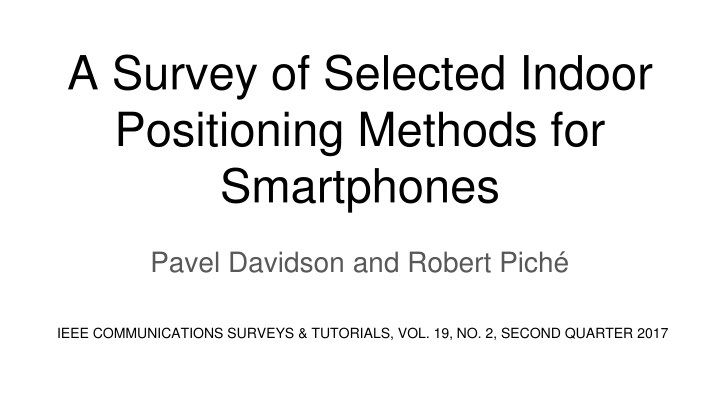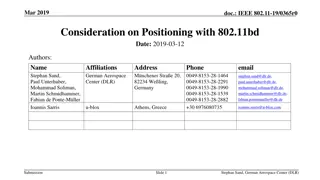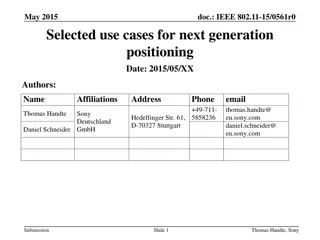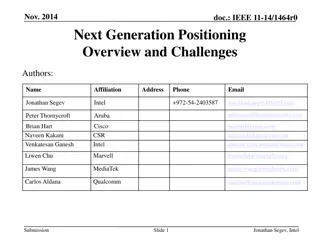Overview of Indoor Positioning Methods for Smartphones
This paper delves into various indoor positioning methods for smartphones, including Wi-Fi and Bluetooth-based positioning, magnetic field fingerprinting, map-aided navigation, and the role of self-contained sensors. It also explores combinations of technologies for indoor navigation and the application of machine learning in fingerprint positioning.
Download Presentation

Please find below an Image/Link to download the presentation.
The content on the website is provided AS IS for your information and personal use only. It may not be sold, licensed, or shared on other websites without obtaining consent from the author.If you encounter any issues during the download, it is possible that the publisher has removed the file from their server.
You are allowed to download the files provided on this website for personal or commercial use, subject to the condition that they are used lawfully. All files are the property of their respective owners.
The content on the website is provided AS IS for your information and personal use only. It may not be sold, licensed, or shared on other websites without obtaining consent from the author.
E N D
Presentation Transcript
A Survey of Selected Indoor Positioning Methods for Smartphones Pavel Davidson and Robert Pich IEEE COMMUNICATIONS SURVEYS & TUTORIALS, VOL. 19, NO. 2, SECOND QUARTER 2017
INTRODUCTION This paper provides an overview of the most significant existing methods for indoor positioning on a contemporary smartphone. 1.Wi-Fi and Bluetooth based positioning 2.magnetic field fingerprinting 3.map aided navigation using building floor plans 4.aiding from self-contained sensors
Possible combinations of technologies for indoor navigation include: WLAN (map is used for display purpose only) WLAN and sensors WLAN and indoor map for map-matching WLAN, map-matching and sensors
WLAN AND BLE BASED POSITIONING WLAN access points (AP) broadcast beacon frames, which include the AP s media access control (MAC) address, typically every 100 ms to announce their presence in a certain area. The mobile nodes receive these signals and can identify the AP according to its MAC address. Although WLAN was not designed for positioning, it can be used to estimate user location by exploiting the received signal strength (RSS) measurements.
RSS Based Positioning trilateration location fingerprinting
Radio Map The radio map is created as a part of the offline learning phase and it contains the measured RSS values at known locations called calibration points. Advantage the characteristics of the signal propagation in indoor environment can be captured avoiding difficulties of modeling complex signal propagation. Disadvantage:The radio map accuracy also degrades over time because of the WLAN APs transmitting power variation and other environmental changes.
Example Of A Radio Map The i-th element in the radio map can be represented as:
Application of Machine Learning Methods and Compressive Sensing in Fingerprint Positioning 1.Support vector machines 2.Multiple weighted decision trees 3.Compressive sensing approach
Support vector machines The SVM classifies data by finding the best hyperplane that separates all data points of one class from those of the other. The best hyperplane for an SVM means the one with the largest margin between the two classes. Margin means the maximal width of the parallel to the hyperplane that has no interior data points. Classification of the fingerprint database can obtain optimal nearest neighbor points.
Multiple weighted decision trees In addition to the RSS from different APs, the training dataset includes the device orientation because the RSS is significantly influenced by the different device orientations. This approach is computationally efficient and can be implemented on a resource-constrained mobile devices.
Compressive sensing approach The compressive sensing approach for the radio map reconstruction using only a subset of RSS fingerprints, thus significantly reducing the number of measurements during fingerprinting database update. Compressive sensing is a signal processing algorithm for sparse signals recovery from a small number of noisy measurements by solving an L1-minimization problem. Their location estimator consists of a coarse localizer, where the RSS is compared to a number of clusters to detect in which cluster the node is located, followed by a fine localization step, using the theory of compressive sensing, to further refine the location estimation.
Difficulties With WLAN Based Positioning System Deployment The accuracy of WLAN RSS-based positing systems can be seriously affected by attenuation of WLAN signals by people,heterogeneous mobile devices and their pose. The effectiveness of WLAN based fingerprinting system deployment is characterized mainly by the required time and efforts for site survey and maintenance of fingerprint database to keep it up-to-date.
Devices Heterogeneity 1.Signal Strength Difference (SSD) disadvantage:suffers from RSS noise fluctuations 2.Build a linear regression disadvantage:requires offline training
Attenuation of WLAN Signals by People The experimental results show that the signal strength at a given location varies by up to 5 dBm depending on the direction that the user is facing because the user s body creates a systematic source of error in RSS measurements. Correcting this source of error during positioning phase can be difficult. Hand grip is another source of error in the RSS measurements on smartphones because of close proximity of hand to the antenna.
AP Selection Appropriate AP selection can reduce the computational burden and in some cases improve the WLAN based positioning accuracy.Author proposed to reduce computational cost by choosing only a subset of all heard APs with the strongest signal. In this case the position is computed using only information from the selected APs and other APs are discarded.
BLE Based Positioning The emergence of Bluetooth Low Energy (BLE) beacons opens up a new generation of indoor positioning systems that can be more accurate, reliable and efficient. BLE can be used in new applications for a multitude of new markets such as IoT, connected home, health, omnichannel retail, ambient intelligence, augmented reality, and mobile advertising.
Positioning With BLE Beacons Indoor positioning based on BLE can use the same methods as WLAN based positioning, namely, fingerprinting. One difference is that BLE is available in class 1 and class 2 versions, where class 1 has a data transmission range of up to 100 meters in open spaces while class 2 range is about 10 m. Radio maps for BLE can include one additional parameter describing the class of Bluetooth.Another difference is that BLE can provide very accurate (submeter-level) positioning in proximity mode when the transmitting power is set to low levels.
Accuracy of BLE Based Positioning The authors conducted extensive experiments in indoor environments and compared the positioning accuracy of BLE and WLAN in almost identical environment and conditions. The results showed that BLE based positioning is more accurate than WLAN by around 27 percent.They also demonstrated that BLE propagation model can describe RSS as function of range better than WLAN.
Summary of WLAN and BLE Based Positioning Advantages: 1.The wide dissemination of WLAN infrastructure and the growing number of BLE beacons 2.The presence of integrated WLAN and BLE radio in almost every smartphone. Disadvantages: 1.Radio map creation and maintenance. 2.The low scan rate of WLAN RSS, usually 0.2-0.3 Hz and large errors in RSS measurements due to device heterogeneity, smartphone s orientation, and attenuation of signals by people.
MAGNETIC FIELD FINGERPRINTING Magnetic field fingerprinting uses a map of magnetic field distribution inside buildings for indoor positioning. Disturbances of the Earth s magnetic field indoors are caused mainly by the metal structure of buildings. The positioning approach consists of two phases: offline mapping of the magnetic field measurements at known locations and online positioning by matching the measured magnetic field with the fingerprints from the database. Unlike WLAN or BLE based positioning, magnetic fingerprinting provides only local positioning because of its spatial ambiguity
MAGNETIC FIELD FINGERPRINTING Advantage: 1.The magnetic field is everywhere 2.No pre-installed infrastructure is required Disadvantages: 1.A single fingerprint consists of only a small number of parameters, at most three, but usually two or even one 2.The magnetic field gradient sometimes can be very steep 3.Intermittent magnetic interferences can be significant
MAP-AIDED NAVIGATION INDOORS The goal of map-aided navigation is to exploit prior information contained in maps or building plans to improve positioning accuracy.When an indoor map is available in addition to a WLAN or BLE based solution it can improve the positioning accuracy.
CONCLUSION The most accurate navigation solution is based on a combination of WLAN, BLE, map, magnetic field and sensor based positioning. The trend for augmentation of WLAN/BLE based positioning by all possible sensors will continue in the future smartphone indoor positioning systems.























